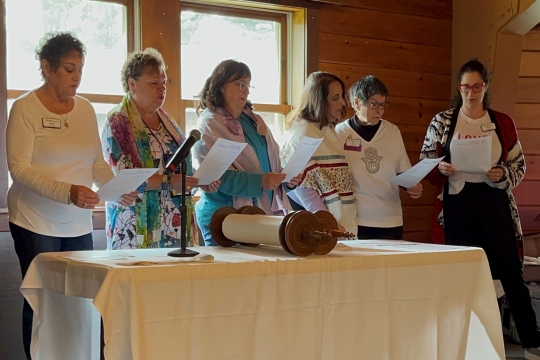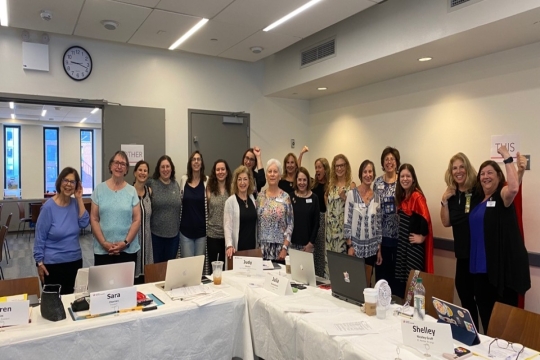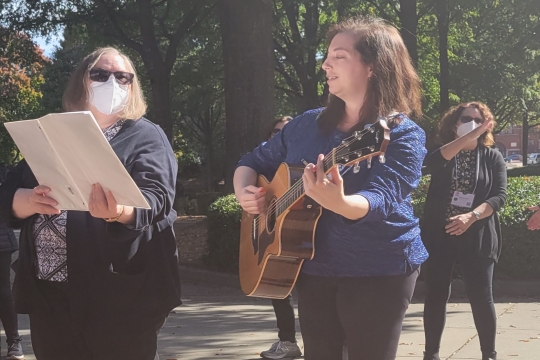By Robin Plotnik
Much of parashah Pinchas comes from looking toward the future, in terms of inheritance, leadership and laws.
The portion opens by completing the story of Pinchas (25:10-18) which began in the previous parashah and continues with the description and enumeration of the census (the second census in the book of Numbers). (25:19-26:65) The story continues with the discussion of future division of land and the courageous tale of Zelophehad’s daughters, who challenge the current practice of excluding women from inheritance. (27:1-11) They not only receive the right to inherit (as daughters in a family with no sons), but successfully argue that the law should be changed for all. The portion continues with Moses learning that he will not enter the Promised Land and with the choice of a successor, Joshua. (27:12-23) Finally, parashah Pinchas ends with a list of special occasions and offerings (28:1-30:1) as summarized in The Torah: A Women’s Commentary, (p. 962).
Much has been written about the daughters of Zelophehad and of the choice of a new leader to succeed Moses. I have chosen, instead, to focus on the census taken in this portion. As a mathematician and amateur genealogist, I am drawn to counting, sorting and organizing things. I see this census as the Torah’s approach to Jewish genealogy, although not complete since it does not include women or those under the age of 20. Yes, it was probably intended for military purposes (evaluating potential troop numbers), and it was definitely used to determine land inheritance for the future. But, I also see it as an important way of recording family history in a moment of time – who is alive and their connection to the tribe. Don’t we all want to know how we are connected?
In my family, on my mother’s side, we emigrated from Eastern Europe and are Ashekenazi, while on my father’s side, we emigrated from Turkey and are Sephardic. Seattle has the third largest Sephardic population in the United States. I love hearing the family stories and my husband has done extensive research building our family tree.
We, in the Seattle area, are very excited to be hosting The 36th IAJGS International Conference on Jewish Genealogy from August 7-12, 2016. We are fortunate to have one of the leading Sephardic and Ladino scholars, Professor Devin Naar, at the University of Washington, and he will be the keynote speaker. “As the chair of the new Sephardic Studies Program of the Stroum Center for Jewish Studies housed within the Jackson School of International Studies, Dr. Naar has begun a pilot project entitled, ‘Seattle Sephardic Treasures,’ which seeks to collect, preserve and disseminate the rich Sephardic and Ladino historical, literary and cultural heritage” (from his faculty page on UW website).
Whether you pursue genealogy or not, you have probably experienced playing “Jewish geography” to find if you are meeting a new cousin or family friend. Whether at your Sisterhood, Area Day, District Convention, Fried Leadership Conference, or Legislative Body meeting, we all want to spend time connecting with women and enriching our friendships. Knowing your family history is a great way to open a conversation with someone new or to connect in a deeper way with family members. It also is a wonderful jump off point for programs.
My Sisterhood recently held our spring Volunteer appreciation program and our speaker was a member, Cynthia Flash Hemphill, who has recently written a book about her family’s history, A Hug from Afar. She told how her mother in Rhodes began at age 9 writing letters (in Ladino) to her uncle who settled in Seattle, and how these continued for 16 years until he finally could help the family immigrate and escape the Holocaust. Her family found the original letters that her uncle had saved and this led to the book. What a wonderful inter-generational discussion we had and sharing of family history as we talked after the presentation! As you plan your programs for the upcoming year, think about including something that will give women the opportunity to share their stories – personal and family history – as a way to connect and get to know each other even better.
I wish you a Shabbat of peace and wonderful connections.
Robin Plotnik is a past president of Sisterhood of Temple B’nai Torah, Bellevue, WA, and also a past congregational president. She serves on the WRJ Board of Directors and chairs online registration for the upcoming Pacific District Convention.
Related Posts
Image

Parashat Yom Rishon shel Rosh HaShanah
September 14, 2023
During the High Holidays, my thoughts turn to the special blessings, prayers, and melodies that shape our journey from Selichot to Rosh HaShanah to the final shofar blast on Yom Kippur. Many of our prayers in the High Holiday liturgy are written in the plural.
Image

Cultivating a Culture of Accountability and Belonging
September 8, 2023
And, we’re off! Many of us have worked over the summer with friends and colleagues to set the calendar for the year ahead, including meetings, events, and other opportunities for gathering.
Image

My Journey from Altar-Girl to Cantorial Soloist
August 11, 2023
I was born a Goldman, and always knew I was Jewish on my dad’s side. Although my whole family was spiritual in their own way, the Jewish side of my family didn’t have warm feelings towards religion, and the only thing passed down to me was the Jewish humor I grew up in New Jersey and had an open...
